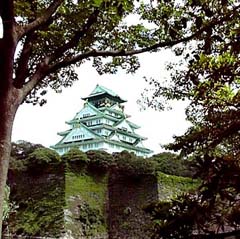
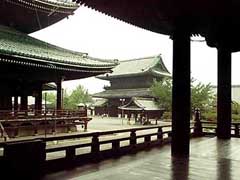

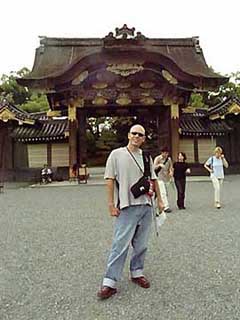

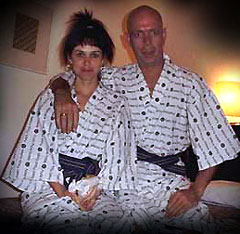
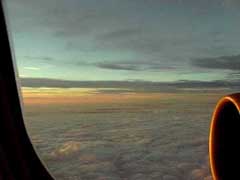
| VISA-AGE.The final part of the Korean Work Visa acquisition process involves a trip out of the country because these can only be issued OUTSIDE Korea. Once one's application has been approved, one then has to take the approval form to a Korean Embassy in another country for the visa to be stamped into one's passport. A silly system, but at least it gave us a good excuse to get on a plane again and take the chance to see Japan at last. We spent a couple of days in the south of Japan, in and around the city of Osaka on the island of Honshu. It's Japan's 2nd-biggest city and is a short haul from the country's original capital, Kyoto, which is still regarded as the seat of Japanese culture. The place is tremendously expensive but you get what you pay for - quality! We were amazed at the neatness and the prettiness of the area, without ANY of the urban debris that normally characterises Asian cities. |  |
| LESS GILT (MORE GUILT?) Despite their horrendous reputation for barbarity in wartime, the Japanese have created a society whose ancient symbols seem elegantly beautiful and anything BUT barbarous. For example, the Hongan-Ji temple in Kyoto which we visited on our first morning there. We bumped into a South African bloke called Lian and wandered around quietly inside what's reputed to be the largest wooden structure in Japan while the sounds of Buddhist chants swirled around us. Quite different from the murky and incense-filled bedlam of the O.T.T-coloured Taoist temples in China. |  |
| GARDEN GAIJIN. (Gaijin means 'foreigner' in Japanese). Later, we visited an ancient Imperial Garden which was all that one would expect from Japanese gardens. Exquisitely laid-out, serence, and a pretty damn decent place to spend time. There were some quirky aspects to the place, though - for example, the cryptic signs reading "Warning! Beware of the bee." and "No through!" Oh - and there were so many huge Koi and other fish in the lake that I'm sure it'd've been possible to walk across on their heads as they massed expectantly for breadcrumbs in the shallows. We didn't have any (breadcrumbs, I mean). |  |
| THATCHED ROOVES! A 45-minute amble through Kyoto followed. We were blown away by the neatness and low-down PRETTY-ness of Japan. It is really completely different from the crap-strewn, grimy, concrete urban armpits that generally pass for cities in Asia. We strolled through the amazingly tidy backstreets of Kyoto, revelling in the quaint mix of old wooden houses and state-of-the-art vending machines on almost every street corner. Hunger and thirst were kept at bay courtesy of the $1.50 Asahi beers from the vending machines and the $1 triangles of sticky rice encased in crisp, dry sheets of seaweed and filled with tuna or beef which are called - erm - dunnowatitisi! ? We finally got to Nijo Castle, in central Ky˘to. It was built in the early 17th century by Tokugawa Ieyasu, the founder of the Tokugawa dynasty of Japan. The walled compound is surrounded by a moat and the main palace building features a wide array of hidden defence mechanisms, including strategically placed squeaking floor boards, (called the Nightingale Floors because of the bird-like chirrups the floorboards make as you move across them) concealed chambers, and trapdoors. There is also a surprising amount of thatch to be seen - as you can see on the main palace gate behind me in the pic. |  |
| OSAKA CASTLE. Monday morning was spent at the Osaka Temple complex, killing time while we waited to collect our visas from the Korean Embassy. Originally built as the HQ of Shogun Hideyoshi (the warlord who first unified Japan about 400 years ago), the place has been flattened more than once by lightning, fires, civil war or American bombers, but it's been nicely restored where possible and is really worth a visit. The top of the main tower provides a fantastic view of Osaka City across the double moats of the castle, but doesn't reveal many traces of the networks of huge canals that used to give this port the nickname of 'The Venice Of Japan' - they were also trashed by Allied bombing towards the end of the Second World War. |  |
| LAFFIN IT UP. We stayed at a hotel in the America Mura (America Square) area of central Osaka. It had a double bed and cost about US$70 a night, a very reasonable price for Osaka. The place even threw in some very nice trad-style robes, complete with the timeless legend "ASAHI PLAZA HOTEL". It's enough to make anyone lose their grip on reality. However, the area itself was even MORE alternative: it has got to be the funkiest place I have ever seen, complete with the latest trend in hairstyles - a huge, shaggy perm that emulates that mini-Afro style that was so 'in' in the 70s. When they're not looking like extras from a 'Mod-Squad' anniversary special, the Japanese are dressing up like rap-stars (complete with fake tan), black leather-encased Goths, safety pin-studded punks, or dayglo-spangled groupies from a Walt Disney merchandising company staff party. There is nothing they will not wear, and the variety of 'looks' is gobsmacking. No wonder people find Japan such a decent place to live - the place BUZZES! We'll be there within the next year or two, that's for sure. |  |
| BACK WE GO. After collecting our visa-stamped passports, we headed back to collect our luggage from the hotel and took the bus back to Kansai Airport. The trip took about 40 minutes, 25 of which were spent passing through one after another of Osaka's port and harbour areas. The place is HUGE! We finally crossed the 3.5km bridge to the man-made island on which the airport lies, and were checked in really quickly - to discover that Kansai airport has the worst airport restaurants and cafes we've ever experienced. Gripe. Well, at least the flight home was nice. Laetitia even took this picture... |  |
---------------
COPYRIGHT. Wotcher. Almost everything on these pages belongs to US. It's ours and we do not allow you to use it unless we've told you you could. If there's anything here that you think belongs to you, then contact us and tell us. Otherwise. hard cheese.